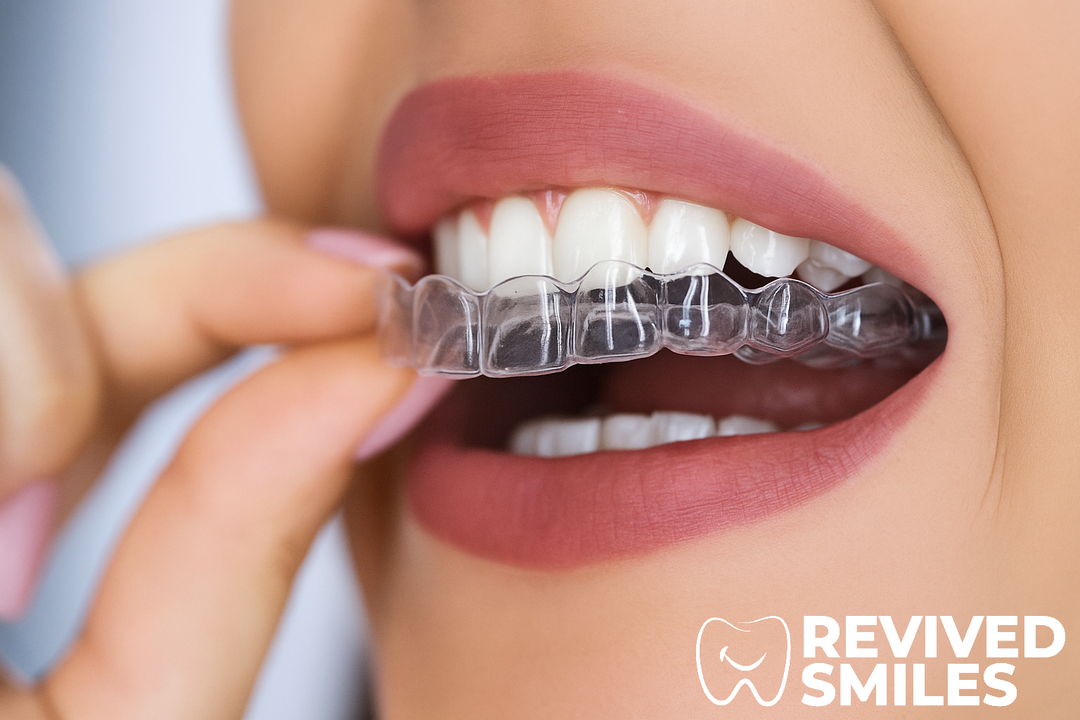Veneers vs Teeth Whitening

A confident, attractive smile has the power to change your entire appearance. It lights up a room, boosts how we feel about ourselves, and often leaves a lasting impression. But over time, habits like morning coffee, red wine dinners, or even simple aging can lead to tooth discoloration and stained teeth. When that happens, many of us start wondering: what’s the best way to get back that bright, natural appearance?
Two of the most common cosmetic dentistry options are veneers vs teeth whitening. Both can help you achieve whiter teeth, but they work in different ways. Let’s explore these cosmetic treatments and see which one delivers the desired results for your unique smile.
Why We All Want Whiter Teeth
There’s something universally appealing about bright, natural teeth. They convey confidence and health, but tooth discoloration is something nearly everyone experiences.
Dietary habits, drinks like coffee or red wine, smoking, and certain medications can cause stains on different tooth surfaces, leading to both surface stains and deep discoloration. Over time, tooth enamel thins, revealing the yellow dentin underneath.
That’s where whitening treatments and dental veneers come in. They help remove stains and restore your smile’s radiance, giving you back that confidence and youthful glow.
What Exactly Are Veneers?
Are you wondering what are dental veneers?
Dental veneers are custom-made shells designed to cover the front surface of your teeth. These thin layers fix issues like chipped teeth, misshapen teeth, uneven teeth, and deep stains. There are two main types: porcelain veneers and composite veneers.
Porcelain veneers are highly durable and stain-resistant. They closely resemble natural teeth and maintain a natural-looking shine. Composite veneers are more affordable but generally last a few years less than porcelain. Both options require a skilled cosmetic dentist to ensure a perfect fit and shade match.
The veneer procedure involves tooth preparation, taking impressions, and a visit to a dental lab. Veneer placement is done at the dentist’s office, where custom-made veneers are bonded using dental cement. Once complete, veneers provide a long-term, permanent solution that enhances both tooth health and overall oral health.
Types of Dental Veneers
Dental veneers are a versatile solution in cosmetic dentistry, designed to address a range of concerns such as discolored teeth, chipped teeth, misshapen teeth, and uneven teeth. With advancements in dental technology, there are now several types of dental veneers available, each offering unique benefits to suit different needs and preferences.
Porcelain Veneers:
Porcelain veneers are the gold standard in cosmetic dentistry for those seeking a natural-looking, long-lasting solution. These custom-made shells are crafted from high-quality ceramic material that closely mimics the translucency and shine of natural teeth.
Porcelain veneers are highly stain-resistant, making them an excellent choice for patients who want to maintain a bright, attractive smile over time. They are ideal for covering deep discoloration, reshaping uneven teeth, and providing a durable, beautiful finish.
Composite Veneers:
Composite veneers are made from a tooth-colored resin that is applied directly to the tooth surface and sculpted by your cosmetic dentist. This type of veneer is more affordable than porcelain veneers and can often be completed in a single visit.
Composite veneers are a great option for fixing minor cosmetic issues like chipped teeth or small gaps. While they may not last as long as porcelain, they still offer a natural appearance and can be easily repaired if damaged.
No-Prep Veneers:
No-prep veneers, as the name suggests, require little to no removal of tooth enamel before placement. These ultra-thin veneers are bonded directly to the front of your teeth, making the process less invasive and more comfortable for many patients. No-prep veneers are a good choice for those who want to enhance their smile with minimal alteration to their natural teeth, especially when only a few teeth need improvement.
Removable Veneers:
Removable veneers, sometimes called snap-on veneers, offer a temporary way to achieve a whiter, more even smile without committing to a permanent procedure. These custom-made appliances fit over your existing teeth and can be taken out as needed.
While not a substitute for traditional veneers, removable veneers are a convenient option for special occasions or for those exploring cosmetic dentistry for the first time.
With so many types of dental veneers available, your cosmetic dentist can help you choose the best treatment to address your specific concerns, whether it’s discolored teeth, chipped teeth, or uneven teeth, ensuring you achieve the smile you’ve always wanted.
What About Teeth Whitening?
Teeth whitening is one of the most popular cosmetic dentistry treatments worldwide. It’s a non-invasive process that uses a bleaching agent, either hydrogen peroxide or carbamide peroxide, to lift surface stains and lighten discolored teeth.
Professional teeth whitening can be done as an in-office whitening treatment at a dentist's office or at home. In-office whitening systems use stronger bleaching agents and specialized lights to accelerate results in about an hour.
At-home whitening treatments include custom trays and milder whitening products that gradually brighten the teeth over multiple visits.
Both whitening treatment options are safe when performed under the supervision of professional teeth experts. Whether you use whitening strips or a dentist-supervised teeth whitening kit, the process can effectively remove stains and give your natural teeth a brighter, more youthful glow.
Veneers vs Teeth Whitening: The Main Differences
When comparing teeth whitening vs veneers, the main difference is in scope and durability. Whitening treatments work to whiten natural teeth by targeting tooth discoloration on the tooth surface, while veneers cover and reshape teeth completely. Veneers can also effectively mask deeper stains that whitening treatments may not fully address.
Veneers offer the ability to fix issues beyond color, like uneven teeth, chipped teeth, or misshapen teeth, creating a complete smile makeover. Whitening treatments, on the other hand, focus solely on lightening tooth enamel and removing stains caused by food, drink, or age.
Here’s a simple comparison:
-
Veneers: Long-lasting, transformative, stain-resistant, and ideal for extensive cosmetic concerns, including deeper stains.
-
Whitening: Quick, affordable, and best to whiten mild surface stains on natural teeth.
When Veneers Make the Most Sense
Veneers shine when whitening results aren’t enough. For example, if you have intrinsic staining from medication or enamel erosion, veneers provide a fresh surface that hides discoloration completely. They’re ideal for patients seeking a total smile makeover, correcting chips, gaps, and uneven shapes all at once.
Traditional veneers and even temporary veneers can completely change your smile’s shape, giving it balance and brightness that whitening alone can’t achieve. If your teeth are deeply stained or you want a full cosmetic transformation, veneers may be the best treatment choice.
When Teeth Whitening Is the Better Fit
If your tooth health is good and you’re mainly concerned with stained teeth or minor discoloration, teeth whitening may be all you need. Whitening treatments can brighten your smile quickly without enamel removal or major dental procedures.
Professional teeth whitening is perfect for patients who want fast, safe, and visible results without permanent alteration. It’s also a great first step before more involved cosmetic work like dental veneers.
Pros and Cons of Veneers
Pros:
-
Veneers offer long-lasting brightness and reshape the teeth for a natural appearance.
-
Porcelain veneers are highly stain-resistant and can last over a decade with proper care.
-
The veneer color is custom-matched for each patient’s smile.
-
Dental veneers provide instant, dramatic improvement to discolored or uneven teeth.
Cons:
-
Requires minor enamel removal before veneer placement.
-
Higher upfront cost than whitening.
-
The veneer procedure is irreversible.
-
May require replacement after a few years due to normal wear.
Veneers are an excellent option for patients who want a permanent solution with natural-looking, long-lasting results.
Pros and Cons of Teeth Whitening
Pros:
-
Affordable and accessible for most patients.
-
Non-invasive and simple to perform.
-
Can show results after about an hour in a dentist’s office.
-
Removes surface stains effectively.
Cons:
-
Temporary results that fade over time.
-
May cause mild tooth sensitivity after treatment.
-
Doesn’t fix chipped teeth or uneven tooth structure.
-
Less effective for deep stains or intrinsic staining.
Teeth whitening systems are best for those who want immediate whitening results without altering the structure of their natural teeth.
Cost Comparison
Professional teeth whitening typically costs between $300 and $800 per session. Porcelain veneers, by contrast, range from $900 to $2,500 per tooth. While veneers cost more initially, they last significantly longer and don’t require constant maintenance.
For patients seeking a budget-friendly improvement, whitening treatments can deliver great results. For those investing in long-term perfection, veneers provide lasting beauty and durability.
Choosing What’s Right for You
Your choice between teeth whitening and veneers depends on your goals, cosmetic concerns, and budget.
-
For mild tooth discoloration or surface stains, professional teeth whitening can give great results.
-
For deep discoloration, chipped teeth, or structural flaws, veneers offer a more comprehensive fix.
-
Always consult a cosmetic dentist before making a decision. They’ll assess your oral health and tooth structure to help you achieve the desired results safely.
How Long Do Results Last?
Veneers typically last 10–15 years with proper care. Porcelain veneers are particularly durable and resist stains caused by dietary habits. Whitening treatments, however, last around six months to a year, depending on what foods and drinks you consume.
If longevity is your goal, veneers provide the advantage of permanence. But if flexibility and affordability matter more, teeth whitening is an excellent choice for maintaining whiter teeth over time.
Caring for Your Smile After Treatment

Maintaining your new smile is key to keeping your results fresh. For veneers, brush and floss daily and visit your cosmetic dentist regularly. Avoid biting into hard foods directly to prevent damage.
After whitening, limit staining foods and drinks, and consider touch-ups every few years. Good oral health habits will help preserve both treatments for years to come.
Why Professional Advice Matters
Every patient’s teeth and cosmetic needs are unique. Professional teeth whitening and dental veneers both require extensive expertise to ensure safety and the best outcome. A cosmetic dentist can recommend the right bleaching agent, explain tooth bleaching procedures, and help you maintain long-term tooth health.
At Revived Smiles, we specialize in creating radiant, natural-looking smiles using both veneers and professional whitening treatments. Whether you want to fix deep stains, enhance tooth surface smoothness, or simply brighten your natural teeth, our dentists can guide you to the ideal smile makeover.
FAQs
What lasts longer, veneers or teeth whitening?
Veneers typically last 10–15 years or more with proper care, while whitening results usually last 6–12 months before a touch-up is needed.
Do veneers look more natural than whitened teeth?
High-quality porcelain veneers are designed to closely mimic natural enamel, often giving a more natural and consistent appearance than whitening treatments.
What is the cost difference between veneers and teeth whitening?
Professional teeth whitening generally costs between $300 and $800 per session, while veneers range from $900 to $2,500 per tooth, depending on the material and the dentist’s expertise.
Which option is less invasive: veneers or whitening?
Teeth whitening is the least invasive option since it doesn’t require enamel removal or reshaping of the teeth. Veneers involve a small amount of enamel removal for bonding.
Can I start with whitening and switch to veneers later?
Yes, many patients begin with professional teeth whitening to brighten their natural teeth and later choose veneers for a more comprehensive, long-term enhancement.
The Bottom Line
When it comes to teeth whitening and veneers, both can make a remarkable difference. Veneers provide a comprehensive, permanent solution that reshapes and brightens your smile, while whitening treatments offer a fast, convenient way to remove stains and enhance your natural appearance.
Whatever you choose, trust your cosmetic dentist to guide you. With the right care, your smile will not only look incredible but reflect the confidence you feel inside.





Leave a comment